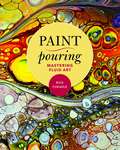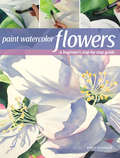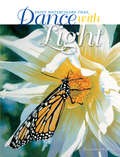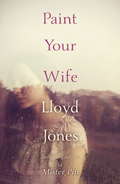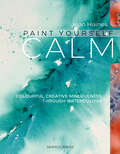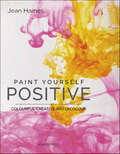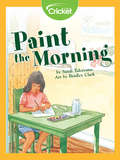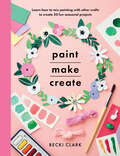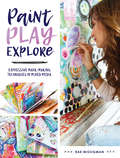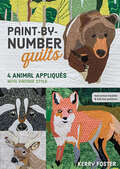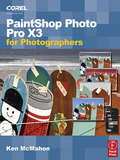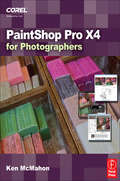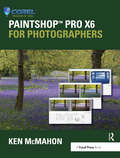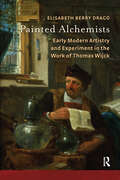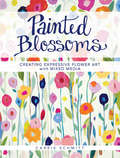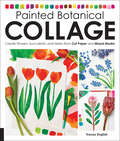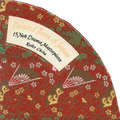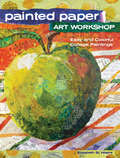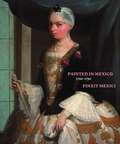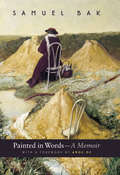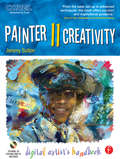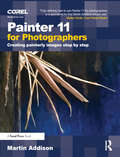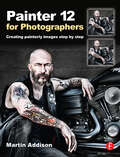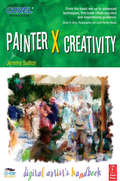- Table View
- List View
Paint Pouring: Mastering Fluid Art
by Rick CheadlePaint Pouring is a form of abstract art that uses acrylic paints with a runny (fluid) consistency. The acrylic paints react with each other when combined to make interesting and visually organic motifs. Fluid acrylics can be used on many types of substrates through various techniques such as pouring, dripping, swirling, glazing, dipping, and more to create dazzling and masterful effects. This book provides everything you will need to become a paint pouring artist. Learn to: Set up your paint pouring studio on a budget Complete your supply list Discover a variety of techniques Properly handle and care for your art Establish appropriate mixing ratios Achieve correct paint density And many other lessons crucial to the craft This new art form is fun for all ages. Become a fluid art master today.
Paint Watercolor Flowers: A Beginner's Step-by-Step Guide
by Birgit O'ConnorYou can paint beautiful blooms, step by step! Sunflowers, orchids, daffodils, lilies...your brush can bring these and more to life with Paint Watercolor Flowers. Master watercolorist Birgit O'Connor guides you every step of the way, from selecting essential watercolor supplies, to practicing basic painting techniques, to capturing the unique details of a variety of flowers, to showing them off in striking, color-rich compositions. Learn how to paint nine different flowers, with each demonstration covering important concepts you need for successful results. Friendly, easy-to-follow instructions make flower painting fun and doable for any artist, whether you are new to the medium or simply want to try a subject you haven't painted before.Detailed instruction on color, value, creating shadows, composition and more3 negative painting demonstrations9 start-to-finish flower painting demonstrations exploring topics such as creating backgrounds, layering color, values in white flowers, values in colored flowers and much moreLearn to play with gorgeous color and water effects, expressing yourself with the unparalleled beauty of nature's bouquet.
Paint Watercolors That Dance with Light
by Elizabeth KincaidElizabeth Kincaid invites readers to follow her proven techniques for painting dazzling scenes drenched in color. Her beautiful flowers, foliage and landscapes will have readers eager to create their own--and they will, using: Easy-to-follow step-by-step instructions that take the mystery out of composition, color, light and shadow A practical guide to masking and glazing Newly trained eyes to visualize before painting and to better perceive abstract form, value, line and color All levels of watercolorists, as well as color enthusiasts of all mediums, will enjoy using Kincaid's tips to create vivid paintings infused with light!
Paint Your Wife
by Lloyd JonesThe next morning Alma showed up with his tin case of pencils and his sketchbooks. She showed him through to the sitting room. She had an idea that a sitting was a formal occasion and in preparation had gone around the room straightening cushions and pulling off furnishing covers. She had dressed herself up in her Sunday best, a black skirt and red blouse. She had been toying with putting a flower in her hair.Long ago, when the men were away at the war, Alma began painting the women of the town. Alice, his favourite, returned his attentions, and when her husband George came home from the war, he set out to prove his love and reclaim his wife by moving a hill to improve the view for her - with a spade and wheelbarrow.Now, decades later, the townspeople, looking to escape various corners of despair, turn to Alma's drawing classes and, in doing so, learn to rediscover each other. For when you draw, the only thing that matters is what lies before you. Paint Your Wife is a colourful, sensual novel, brimming with rich stories and even richer characters.
Paint Yourself Calm: Colourful, Creative Mindfulness Through Watercolour
by Jean HainesDiscover the happiness benefits of putting brush to paper with a guide that puts judgment aside and “encourages simple enjoyment of painting” (Library Journal).Meditative, peaceful, and calming, watercolour painting offers a sense of control and self-worth to everyone, with no judgment or goal beyond the joy of painting itself. This book shows you how to calm and enhance your outlook through the movement of brush on paper.Master artist Jean Haines leads you through the journey, putting the emphasis on the joy of play rather than on pressure to perform or produce—and showing you how to wipe away your worries with the soothing, gentle strokes of watercolour paint.“Starting from the premise that everyone can paint, Haines frees readers of the goals and expectations of end results, and encourages simple enjoyment of painting. Open-ended, detailed exercises guide readers through experimenting with paint to gain a sense of control; to relieve stress; to escape; or to be in a better mood. The emotional and psychological properties of color are discussed as are obstacles to creativity and happiness. . . . [a] unique blend of self-care and expression.” —Library Journal
Paint Yourself Positive: Colorful Creative Watercolour
by Jean HainesBestselling international author and artist Jean Haines’ new book takes readers on an exciting journey through painting. Not just a book for artists, this is for anyone looking for a way of enhancing their life and mood through paint. It’s also a way into art for people who have never painted and may even have been told they 'can’t paint’ at an early age. If you love the idea of sitting down and playing with colour and paint as a distraction from the stresses of modern life, then this is the book for you!All of Jean’s books have promoted the life-enhancing effects of painting, and this is especially relevant in Paint Yourself Positive. Whether you can already paint or not, the aim of the book is for you to create in a way that you find pleasing, increases your self-confidence and leaves you feeling energized. Jean will very soon have you wanting to pick up a paintbrush and start to paint – and loving every second of it.
Paint the Morning
by Sandi TakayamaMalia is not interested in drawing monsters or sculpting pots. All she wants to do is paint the morning.
Paint, Make, Create: Learn How to Mix Painting with Other Crafts to Create 20 Fun Seasonal Projects (Crafts Ser.)
by Becki ClarkPaint, Make, Create showcases seasonal, multi-craft projects all woven together by painting. Designed for all abilities, the 20 engaging activities will guide you through the seasons and include working with clay, printing, collaging, sewing and embroidery with a fun and modern painterly twist. Including a comprehensive guide to getting started with painting, Paint, Make, Create will help you develop an understanding of types of paints, surfaces, color palettes and mixing your own colors while also arming you with the tools and confidence to create your own original pieces. Drawing on author Becki’s vast experience in the creative world, alongside each project's step by step guide are helpful hints and tips, perfect for beginners wanting to experiment with paints. Your creativity will flourish with each contemporary craft project, from creating painterly table settings for Summer gatherings right through to painting Christmas gifts and decorations.
Paint, Play, Explore: Expressive Mark-Making Techniques in Mixed Media
by Rae MissigmanDiscover the marks for your most authentic art! Mixed-media artist Rae Missigman identifies herself as a "mark-maker." Ever in the forefront of her art, organic shapes and graphic marks are what give her work a sense of authenticity. With an adventurous, anything-goes attitude to expressing herself, she is just as likely to use a celery stem, a sewing machine or a cardboard tube as she is a brush, a palette knife or her own hands. In Paint, Play, Explore, Missigman helps you discover those marks that define you as an artist, and weave them into your art in new and interesting ways. Through page after page of creative exploration, you'll become a collector of tools--traditional and unconventional mark-makers that will become an extension of your unique voice. You'll become a tinkerer as you recycle and repurpose, striving to turn something ordinary into something extraordinary. You'll become an explorer as you draw with your non-dominant hand, create "blindly" using resists, stamp with your own handcrafted organic ink, and follow other creative prompts to widen and shape your artistic world. Whether you're just starting your creative adventure or you're looking to break through to the next level, Paint, Play, Explore will set you in motion. Setting the tone with her upbeat vibe and joyful use of color, Missigman pushes you to find your own beautiful artistic "fingerprint" to create work that is interesting, full of life and distinctly yours...and above all, to embrace the journey. "The shapes you choose to etch in your work, free flowing and heartfelt, are a part of what makes the art your own. Tools in hand, your marks will find you and you will begin to recognize yourself in your creations." You're going to need a bigger creative toolbox...60+ mark-making tools and mediums23 stepped-out demonstrations on collage, one-brush painting, monoprinting, resists, transfers and other fun and versatile mark-making techniques4 start-to-finish projects for turning marks into inventive art
Paint-by-Number Quilts: 4 Animal Appliqués with Vintage Style
by Kerry FosterThis full-color beginner’s guide lets you create four pictorial animal quilts with easy-to-use, paint-by-numbers color keys!These beautifully intricate quilts may look complicated, but Kerry Foster makes them easy with this step-by-step guide. By taking the guesswork out of fabric choice, anyone can bring a sophisticated use of light and shadow to these sewn animal portraits. Use the color keys and diagrams to easily choose a palette from your fabric stash and create amazing images with turned-edge machine appliqué. Choose from a fabulous fox, an adorable raccoon, a majestic stag, and a fierce bear!
PaintShop Photo Pro X3 for Photographers
by Ken McMahonIf you are a digital photographer who's new to Paint Shop Pro Photo or digital imaging in general, or have recently upgraded to the all-new version XX, this is the book for you! Packed with full color images to provide inspiration and easy to follow, step-by-step projects, you'll learn the ins and outs of this fantastic program in no time so you can start correcting and editing your images to create stunning works of art. Whether you want to learn or refresh yourself on the basics, such as effective cropping or simple color correction, or move on to more sophisticated techniques like creating special effects, everything you need is right here in this Corel-recommended guide. Useful information on printing and organizing your photos and a fantastic supplemental website with tons of extras rounds out this complete PSPP learning package.
PaintShop Pro X4 for Photographers
by Ken McMahonGreat for those new to PaintShop Pro or digital imaging in general, this book is packed with inspirational, full-color images and easy to follow, step-by-step projects that will have you producing great images in PaintShop Pro in no time! Everything you need to turn your photos into stunning works of art is right here in this Corel-reviewed guide. In this new edition, Ken covers new features including how to make the most of the newly organized workspaces, use the redesigned HDR tool, and instantly publish photos on Flickr and Facebook. Squeeze every ounce of detail out of RAW files using the newly enhanced Camera RAW Lab and improve tonal range with the new Fill light/Clarity filter. This book has everything a photographer needs to take their photos to the next level with PaintShop Pro. Be sure to visit the companion website www.gopaintshoppro.co.uk for practice files, bonus tutorials and other fabulous resources.
PaintShop Pro X6 for Photographers
by Ken McMahonWritten for photographers of all levels, PaintShop Pro X6 for Photographers is packed with inspirational, full-color images and easy-to-follow step-by-step projects that will have you producing great images in PaintShop Pro in no time! Everything you need to enhance and improve your digital photography is right here in this Corel® endorsed guide. In this new edition, Ken McMahon looks at the pros and cons of the new, faster 64-bit version of the software and covers new features, including working with the Instant Effects palette, using the Smart selection brush, mapping photos, automatically tagging people, and uploading to Facebook, Flickr, and Google+. Other program features—selections, masking, layers, adjustments and effects, HDR, and scripting—are explained through practical examples that are just as relevant for older versions of the software. This book has everything a photographer needs to take their photos to the next level with PaintShop Pro. Learn from PaintShop Pro expert Ken McMahon with the most authoritative book on PaintShop Pro endorsed by Corel®. Completely revised and updated with all of the new features in X6—get up to speed with 64-bit processing power, new selection tools, workspace enhancements, and much more. A complete learning package with full-color screen shots and examples, and step-by-step projects at the end of each chapter.
Painted Alchemists: Early Modern Artistry and Experiment in the Work of Thomas Wijck (Amsterdam Studies in the Dutch Golden Age)
by Elisabeth Berry DragoThomas Wijck’s painted alchemical laboratories were celebrated in his day as artful and ingenious. They fell into obscurity along with their subject, as alchemy came to be viewed as an occult art or a fool’s errand. But these unusual pictures challenge our understanding of early modern alchemy-and of the deeper relationship between chemical workshops and the artists who represented them. The work of artists, like the work of alchemists, contained intellectual-creative and manual-material aspects. Both alchemists and artists claimed a special status owing to their creative powers. Wijck’s formation of an artistic and professional identity around alchemical themes reveals his desire to explore this curious territory, and ultimately to demonstrate art’s superior claims to knowledge and mastery over nature. This book explores one artist’s transformation of alchemy and its materials into a reputation for virtuosity-and what his work can teach us about the experimental early modern world.
Painted Blossoms: Creating Expressive Flower Art with Mixed Media
by Carrie SchmittDo you long to cultivate more creative joy in your painting?Flowers are organic, wonderfully forgiving subjects. Each one is unique; you can't paint one wrong! Painted Blossoms will encourage you to welcome creativity with ease as you discover ways to tend the garden within. In addition to watching yourself grow through seven different stepped-out flower projects, you'll learn basic design elements, how to get unstuck from the mud, how to carve your own stamps, cut your own stencils and more.A sampling of what you'll add to your creative toolshed:Techniques for creating a wide variety of flower shapesThe know-how to incorporate key design elements into your floral paintingsHow to absorb inspiration beyond the garden to include your favorite symbols, intentions and storiesTips and advice from over a dozen established artists--each with a unique floral style Nurture today what's waiting to bloom within you with Painted Blossoms!
Painted Botanical Collage: Create Flowers, Succulents, and Herbs from Cut Paper and Mixed Media
by Tracey EnglishWith Painted Botanical Collage, artists of all skill levels will learn to create lifelike botanical artwork—featuring flowers, succulents, and herbs—using painted background papers and elegant collage techniques. A unique technique book, Painted Botanical Collage will show you how to create your own collage materials. This guide takes you step by step through creating mixed-media painted papers, then using them—along with tissue paper, art papers, and found paper, such as magazines—to create perfect collage materials. Cut these decorative papers into plant and flower parts to assemble your designs, adding details using various media.Working from nature is central to this technique—look closely at the palettes and shapes in actual flowers to create realistic stylized representations. Painted Botanical Collage includes instruction on creating flowers, cacti, succulents, leaves, and other popular botanicals—over 30 beautiful designs in all. Join in the fun as British artist Tracey English shares the methods behind the magical flower collages that charm and delight her Instagram followers.
Painted Fans of Japan
by Reiko ChibaThe chief purpose of this modest little book is to present for Westerners some of the gorgeous paintings found on fans used in tne traditional Japanese Non drama. Painting as limited to conform to the fan shape has teen practiced for hundreds of years in Japan, even hy such immortal artists as Sotatsu and Korin. Until now, however, there has heen no popularly availahle volume of reproductions to reveal the almost limitless possibilities in color, design, and perspective within this restricted form of painting, The artists whose works are reproduced in this book are unknown, and the time when the works were painted can only he estimated as early (1601-1741), middle ( 1742-1791 ) , or late ( 1792-1867 ) Totugawa, the period of Japanese history that extended from the beginning of the seventeenth century to well past the middle of the nineteenth.
Painted Fans of Japan
by Reiko ChibaThe chief purpose of this modest little book is to present for Westerners some of the gorgeous paintings found on fans used in tne traditional Japanese Non drama. Painting as limited to conform to the fan shape has teen practiced for hundreds of years in Japan, even hy such immortal artists as Sotatsu and Korin. Until now, however, there has heen no popularly availahle volume of reproductions to reveal the almost limitless possibilities in color, design, and perspective within this restricted form of painting, The artists whose works are reproduced in this book are unknown, and the time when the works were painted can only he estimated as early (1601-1741), middle ( 1742-1791 ) , or late ( 1792-1867 ) Totugawa, the period of Japanese history that extended from the beginning of the seventeenth century to well past the middle of the nineteenth.
Painted Paper Art Workshop: Easy and Colorful Collage Paintings
by Elizabeth St. HilaireThis is where painting meets collage! You can create beautiful art with amazing depth and texture, using easy collage techniques and paper you paint yourself. Popular workshop instructor Elizabeth St. Hilaire makes it fun and simple no matter what your skill level! Start with materials you probably already have--fluid acrylics, stencils, a few household items and paper--and hand-paint your personalized paper palette using basic techniques anyone can do. Then move through each step of composing your own work of art. You'll find beautiful, meaningful examples of the how and why on every page. You'll learn how to: develop your composition, how to work with simple shapes, important lessons on value and much more.More than 30 techniques for painting your own decorative papersStep-by-step instructions for creating your own painted paper collage-from underpainting and directional ripping and tearing to auditioning your papers and combining collage with mixed mediaA spectacular gallery of paper paintings to inspire and dazzle--still lifes, figures, animals and landscapes
Painted in Mexico, 1700-1790: Pinxit Mexici
by Ilona KatzewThis beautiful and groundbreaking book provides the first in-depth reassessment of 18th-century Mexican painting, making accessible an extraordinary body of images, alongside compelling new scholarship. This stunning volume represents the first serious effort to reposition the history of 18th-century Mexican painting, a highly vibrant period marked by major stylistic changes and the invention of new iconographies. Exquisitely illustrated with newly commissioned photography of never-before-published artworks, the book provides a broad view of the connections of Mexican painting with transatlantic artistic trends and emphasizes its own internal developments and remarkable pictorial output. During this time painters were increasingly asked to create mural-size paintings to cover the walls of sacristies, choirs, staircases, cloisters, and university halls among others. Significantly, the same artists also produced portraits, casta paintings (depictions of racial mixing), folding screens, and finely rendered devotional images, attesting to their extraordinary versatility. Authored by leading experts in the field, the book’s essays address the tradition and innovation of Mexican painting, the mobility of pictures within and outside the viceroyalty, the political role of images, and the emphasis on ornamentation. Rounding out this volume are over 130 catalogue entries that offer new and authoritative interpretations.
Painted in Words: A Memoir
by Samuel S. BakAt my first sight of a painting by Samuel Bak, I had the keen sense that he was telling me stories with his brush. Now that at long last he has written this book, I find it no wonder that he has painted with his pen.... Among the tens and hundreds of books I have read about the pre-Shoah and post-Shoah period... Bak's book is unique. Despite being suffused with a sense of loss, horror, degradation, and death, it is ultimately a sanguine, funny book, full of the love of life, rocking with an almost cathartic joy. At times I found myself bursting out laughing... a marvelous ode, a colorful hymn to the forces of life, love, creation, and the joys of the senses. --From the Foreword by Amos OzIn Painted in Words internationally renowned artist Samuel Bak sets aside his brushes to narrate the stories of his life--as a child in Nazi-occupied Vilna, as a youth in European refugee camps, and as a maturing artist in Israel, France, Italy, Switzerland, and the United States. With gentle humor, the child prodigy of the faraway past and the accomplished artist of today engage in a spirited dialogue from which emerges a self-portrait of "The Artist as a Young--and middle-aged and aging--Survivor." The brilliance, vision, and virtuosity that Bak brings to his painting are equally in evidence in his writing. This deeply touching work is an important contribution to Holocaust literature and art history.
Painter 11 Creativity: Digital Artist's Handbook
by Jeremy SuttonJeremy Sutton is one of the world's premier Painter artists (www.JeremySutton.com and www.PaintboxJ.com), and in this brand new edition of his best-selling Painter Creativity: Digital Artist's Handbook, he shows you the methods and techniques he's developed over the years to perfect his art and earn him the title of Corel Painter Master. This edition has been completely revamped to cover all of the new features in Corel Painter 11 and the Wacom Intuos4 pen-tablet, including: *The new Hard Media brushes *Complete visual summary of all brushes, new and old, in Painter 11 *Revised and updated command shortcuts *New way of creating and controlling Reference Layers (formerly Free Transform) *Programming suggestions for new Intuos4 Express Keys and Touch Ring *And much more! Inside, you'll find comprehensive coverage of the way that Jeremy uses the Painter 11 brushes and the Wacom Intuos4 pen-tablet for drawing and painting. You'll learn how to paint from scratch as well as a loose expressionistic approach to painting from photographs as you follow the clear step-by-step instructions throughout the book. Focused, in-depth case studies provide you with the expertise and guidance you'll need to become your own master of this wonderful world of digital painting. Jeremy balances technical instruction with artistic advice, including a whole chapter on going for it with color. In addition to Jeremy's own works of art, you'll find a gallery of images created by painters who have studied his methods, showing you examples of how you can apply his teaching to your own style and subject matter. Please note that the kindle edition of this title does not include the bonus CD.
Painter 11 for Photographers: Creating painterly images step by step
by Martin AddisonWhether you are new to Painter or a seasoned pro wanting to take your digital art to the next level, this inspirational book and DVD package will show you how to get the most out of Corel's powerful painting software.Starting with the basics and moving on to cover brushes, textures, cloning, toning and other effects, Martin Addison will help you master the tools and features needed to transform your photographs into stunning works of art. Over 2 hours of video tutorials and clear, step-by-step examples take you through the techniques in a no-nonsense manner, with all images provided on the accompanying DVD so you can learn by doing. Packed with beautiful images to illustrate what can be achieved with the right skills and know-how, Painter XI For Photographers will inspire you to get creative with your personal or commercial photographs.
Painter 12 for Photographers: Creating painterly images step by step
by Martin AddisonTransform your photographs into stunning works of art with this fully updated, authoritative guide to the all-new Painter 12. Whether you are new to Painter or a seasoned pro wanting to go further with your digital art, Painter 12 for Photographers will show you how to get the most of Corel's powerful painting software. Starting with the basics and moving on to cover brushes, textures, cloning, toning, and other effects, Martin Addison will help you master the techniques needed to transform photographs into beautiful painterly images. Packed with vivid images to illustrate what can be achieved with the right skills and know-how, Painter 12 for Photographers will inspire you to get creative with your photographs.
Painter X Creativity: Digital Artist's handbook
by Jeremy SuttonEmpower your artistry in the digital environmentThis unique Painter book addresses both creative and technical proficiency, helping you step ahead in today's world of photography, art, multimedia, and design. This lavishly illustrated guide speaks directly to all visual artists and shows you how to combine traditional and stateof-the-art media to capture the essence of your vision.Fully updated for Corel Painter X and the newest range of Wacom graphics tablets, progressive, well-structured tutorials from beginner to advanced level, case studies, and examples of art will inspire your imagination at every stage. Let world-renowned Painter master Jeremy Sutton guide you step-by-step in how to experiment with creative ideas and techniques that you can adapt to your own style.New time-saving tips, workflow strategies, and keyboard short cuts allow you to quickly transform your work with Corel Painter X's outstanding natural-media tools. From expressive paintings to evocative collage portraits, oil impressionism, live portrait paintings, and painterly effects for video, television, and the Web, you get the best techniques through...*Clear explanations with colorful screen grabs and inspiring artworks that lead youthrough the sophisticated and creative Painter tools*Practical, hands-on tutorials, and project illustrations that show you every step inimage development, including multimedia artist techniques*A CD-ROM packed with unique custom brushes, tutorial images, and additional artmaterials not supplied with Painter XIncluded on the resource CD:*48 extra brushes including many unique custom brushes not supplied with Painter *38 custom color sets*Jeremy's SupaDoopa custom palettes to help speed up your workflow*Collection of Jeremy's favorite Image Hose nozzles, paper textures, and patterns to greatly enhance the variety and richness of art materials available at your fingertips*Gain instant access to Jeremy's interface customization and optimize your creativity with unique custom workspaces, new to Painter X*4 QuickTime movies including a studio tour, artwork commentary, and details on Wacom tablets*Have fun practicing with 28 tutorial images!
